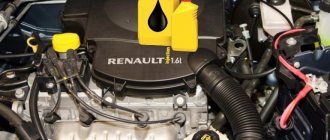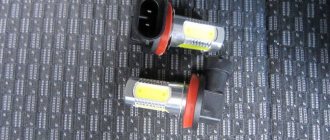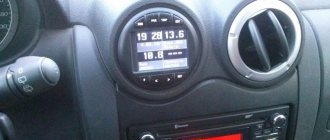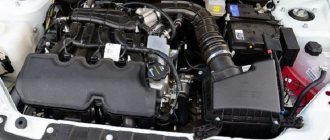February 17, 2015 Lada.Online 431 556 31
Depending on the year of manufacture, the Largus may be equipped with a Renault or VAZ engine. Currently, only domestic engines are installed on this car. Let's take a closer look at the technical characteristics of Lada Largus engines, as well as the features of their assembly.
- Renault-Nissan K7M
(8 valves) with a volume of 1.6 liters is capable of developing a power of 84 hp. This motor is installed on the “standard” and “norm” configurations. - Renault-Nissan K4M
(16 valves) is slightly more powerful, also 1.6 liters, but has a power of 105 hp. or 77 kW. The motor is provided for the “luxury” configuration. - VAZ 11189
(1.6 liter, 87 hp, 8 valves) began to be installed instead of K7M in 2015. - VAZ 21129
(1.6 liter, 106 hp, 16 valves) began to be installed instead of Renault K4M in October 2021. - VAZ 11182
(1.6l., 90hp, 8kl) began to be installed on Largus FL from March 2021
Both are Renault Alliance engines. Since December 2015, AVTOVAZ began installing its 8-valve VAZ-11189 engine. You can get acquainted with its pros and cons from this review.
Both engines from Renault-Nissan are paired with a 5-speed manual transmission. At the moment, AVTOVAZ does not plan to equip the Lada Largus with an automatic transmission.
Lada Largus engines are distinguished by high elasticity, and the manual gearbox is distinguished by precise gear shifting. For dynamic acceleration and confident overtaking, the engine power is quite enough. Both Lada Largus engines comply with Euro 4 environmental requirements.
Depending on the vehicle configuration, there are several options for installing auxiliary equipment on the engine:
- car with non-power steering;
- car without power steering with air conditioning;
- vehicle with hydraulic power steering;
- car with hydraulic power steering and air conditioning.
Technical characteristics of Renault engines
| Options | Engine model | |
| RENAULT, K4M | RENAULT, K7M | |
| Injection type | Electronically controlled multipoint fuel injection | |
| Fuel type | Gasoline Premium-95 GOST 51105-97 | |
| Number and arrangement of cylinders | 4, in-line | |
| Number of valves | 16 | 8 |
| Cylinder operating order | 1-3-4-2 | |
| Direction of rotation of the crankshaft (camshaft drive side) | ||
| right | ||
| Cylinder diameter/piston stroke, mm | 79,5×80,5 | |
| Working volume, cm3 | 1598 | |
| Compression ratio | 9,8 | 9,5 |
| Toxicity standards | Euro 4 | |
| Power at 5500 rpm, kW (hp) | — | 62 (84) |
| Power at 5750 rpm, kW (hp) | 77 (105) | — |
| Maximum torque, N.m (at rpm) | 148 (3750) | 124 (3000) |
| Volume of oil poured into the engine lubrication system, including oil filter, l | 4,8 | 3,3 |
Description of the K7M engine (Renault Logan/Sandero/Largus)
In 2010, the K7M 800 engine appeared, which replaced the K7M 710. No design changes occurred, except that the engine was strangled, bringing it up to the Euro-4 environmental standard, while the power decreased from 86 hp to 83 hp. With.
The disadvantages of the engine remain the same:
- high fuel consumption.
- At idle the speed often fluctuates.
- Every 20-30 thousand km the valves need to be adjusted.
- no hydraulic compensators.
- If the belt breaks, the valve bends; it is recommended to change the belt every 60 thousand km.
- crankshaft oil seal leaking.
- the engine is noisy.
- there are vibrations during operation.
If you look at the engine from the positive side, it is worth noting its high reliability; according to the passport, the engine life is about 400 thousand km, but in practice it is a little more.
Let's sum it up
High quality cars and excellent comfort - these factors are not yet the prerogative of the domestic car manufacturer. Unfortunately, the quite promising and interesting Lada Largus project remains, if not unprofitable, then certainly unsuccessful. In 2012, when mass production of this car was just beginning, Russian potential buyers were quite inspired by the reincarnation of the popular Renault Logan station wagon on the Russian assembly line, but expected a low cost. The price of the car even then exceeded Renault's figures for the discontinued MCV.
If a new generation Logan MCV appeared on the market, which in Europe costs about the same as the obsolete Largus in Russia, the buyer would not even look at the domestic manufacturer. It seems that AvtoVAZ is accustomed to the fact that duties and taxes on foreign cars are raised precisely to develop the concern’s production. This is a false course of development, which is practiced today only in the CIS countries. Let's hope that the next generation of Largus will be more successful, beautiful and practical. What do you think about the Lada Largus project and the practice of Atovaz copying European developments?
Description of the K4M engine (Renault Logan/Sandero/Largus)
It is a development of the K7M series, with a new cylinder head, already 16 valve. There are many differences: K4M is quieter, it is more economical, there are no vibrations and many other advantages.
Motor disadvantages:
- expensive spare parts.
- If the belt breaks, the valve bends; it is recommended to change the belt every 60 thousand km.
- there are failures in work.
- Low-quality fuel causes the revs to fluctuate.
- troit (most often the problem is in the ignition coil, injectors or spark plugs).
- Unstable operation and floating speed are usually caused by the crankshaft position sensor or ignition coil.
If you choose between K7M and K4M, then the choice should definitely remain with the more modern and practical K4M.
For those who intend to buy a K4M model engine, this is a must-read!
Know that any 16-valve engine is very sensitive to the choice and quality of oils. The engine in Largus at the plant is filled with imported material:
- SHELL PC 1448, 0W30
- ELF SOLARIS RNX, 5W30
At one time, LUKOIL Genesis RN oil was used, the viscosity of which corresponds to the 5W40 class. We have already written in more detail about choosing oil for a 16-valve engine here.
What “they” use as “5W30” is called “5W40” by us.
The oil filter, if we talk about 16 valves, also has strict requirements. And with an 8-valve valve everything looks simpler: the choice of oils has 20 options, and the filter can be changed “every time” (but this is already against the regulations).
Two features of the Renault engine
The reader may have noticed that K4M engines require more oil and low-temperature oil must be poured into it: 0W is for temperatures “lower than minus 35”. The bottom line is that the engine really has problems with winter starting. But it also has a phase regulator to provide better traction at the bottom.
Gear phase regulator in Renault two-shaft internal combustion engines
On VAZ-11189 engines there is no phase adjustment system.
For Largus station wagons, the K4M engine was modified: the phase regulator was replaced with a regular gear. Be aware of this!
Hydraulic compensators mounted on the valve lifters make the K4M engine silent. In general, the combination of “cast iron block + hydraulic compensators” is more typical for limousines. So consider that Largus with 16 valves is a limousine. Requiring attention, quality service and expensive materials.
Hydraulics kit for K4M
Whose engine is Lada Largus
Previously, engines for Lada Largus came assembled from the Renault plant in Spain, but recently engines of the K4M series (16 valves, 105 hp) began to be assembled at AVTOVAZ. According to the director of the Power Units project, Francois Goujon, the quality of engines assembled at AVTOVAZ corresponds to the world level.
The AVTOVAZ press service assures that a quality system is used in the production of new engines to ensure that products comply with the international standards of the alliance. In addition to personnel training, it includes control on the production line, during which each assembled engine is tested in different modes on a special stand. The technology also provides for a weekly check, when one of the motors is completely disassembled and the quality of its assembly is analyzed.
[Episode 42]Largus CROSS with updated engine
View and compare engines
closer: Help in buying a new car: .
The price of the LADA Largus with the new engine remained unchanged: the station wagon costs from 635,400 rubles, the van – from 609,800 rubles, the LADA Largus Cross version – from 689,900 rubles. This is the price of models without various discounts, with which the car will cost significantly less.
As for the features of Largus
with a power unit of 106 hp. (VAZ-21129), then about them is expanded.
The VAZ plant has been producing station wagons and vans of the Largus family since 2011. In 2014, the production of station wagons in the “Cross” body was launched. By that time, AvtoVAZ had localized the assembly of K4M engines, but not K7M, supplied by Renault.
The first of the two engines is equipped with 16 valves, and it became the basis for all trim levels of the crossover station wagon. It is this, and not the 8-valve K7M, although 8-valve internal combustion engines are more suitable for the SUV segment. In fact, the K7M engine is inferior to its 16-valve brother in both power and traction characteristics. And if the Lada Largus Cross engine had been 8-valve, neither the factory nor the buyer would have benefited from this. Let's look at the details.
About the domestic VAZ 11189 engine
In April 2021, AVTOVAZ began installing domestic VAZ 11189 engines on Largus. The advantages of this engine are described in one of the issues of “Okay Mechanics”.
| Some measurement results Autoreview | |||
| Options | Cars | ||
| Lada Largus (VAZ engine) | Lada Largus (Renault engine) | ||
| Maximum speed, km/h | 157,1/156,7* | 168,0/167,6 | |
| Acceleration time, s | 0—50 km/h | 4,3/4,8 | 3,9/4,4 |
| 0—100 km/h | 13,9/16,8 | 12,5/14,5 | |
| 0—150 km/h | 61,1/71,6 | 38,9/43,7 | |
| on the way 400 m | 19,3/20,2 | 18,4/19,4 | |
| on the way 1000 m | 36,1/37,8 | 34,1/36,0 | |
| 60-100 km/h (III) | 8,7/10,6 | 9,3/10,6 | |
| 60-100 km/h (IV) | 12,1/15,1 | 12,8/14,1 | |
| 80-120 km/h (V) | 19,3/24,0 | 22,1/23,4 | |
| * Partial load/full load | |||
| Engine characteristics | ||
| Options | VAZ-11189 | Renault K4M |
| Volume, cm3 | 1596 | 1598 |
| Number of valves | 8 | 16 |
| Maximum power, hp/kW/rpm | 87/64/5100 | 102/75/5750 |
| Maximum torque, Nm/rpm | 140/3800 | 145/3750 |
| Cylinder diameter/piston stroke, mm | 82,0/ 75,6 | 79,5/80,5 |
| Compression ratio | 10,3:1 | 9,8:1 |
| Injection type | distributed, electronically controlled | |
| Octane number of gasoline | at least 92 | not less than 95 |
Official figures
The AvtoVAZ company does not rule out that its 89th engine will be “fed” with 92nd gasoline. This option is officially allowed. But for the K4M engine only AI-95 gasoline is suitable, also A-95 or better.
Speed characteristics:
- 8-class: 14.2 s, 158 km/h
- 16-class: 13.1 s, 165 km/h
The acceleration time from zero to 100 km/h is indicated here.
Be aware that different engines on Largus are equipped with different gearboxes. In the first case (8 cells), the gear ratio of the main pair is 4.5. In the second - 4.2! We have already written about changing the oil in them here.
In general, Largus with an 8-valve engine is a family car, not intended for high-speed travel. Acceleration from scratch on it is very brisk, but this is due to the increased gear ratio. Thanks to him, from about 130 km/h the dynamics disappear completely.
The VAZ company promises us better efficiency with the K4M engine, and not with the 11189. The numbers do not differ much, but they are in the region of 8 liters per hundred.
New VAZ 11182 engine
At the beginning of 2021, AVTOVAZ introduced a new 8-valve 1.6-liter engine (VAZ 11182 or AR16SEg2), which first appeared on the Lada Largus FL and will later appear on the Lada Granta FL.
AVTOVAZ writes that the new engine featured an updated connecting rod and piston group, a modernized crankshaft and a gas distribution mechanism. As a result, power is increased to 90 hp, and 80% of torque is available from 1000 rpm, which reduces fuel consumption and reduces shift frequency. In addition, the need to adjust valves before a mileage of 90,000 kilometers is eliminated. The engine is adapted to run on gasoline with an octane rating of 92. Read more about the design in this review. Technical characteristics and reviews about it are at the link.
Let us remind you that you can read about the VAZ 21129 engine here.
Key words: Lada Largus engine
+23
Share on social networks:
Found an error? Select it and press Ctrl+Enter..
Should I buy a used LADA Largus?
"Largus" is not intended for beauty, comfort, dynamic and fast driving. Although the suspension has been adapted to Russian bad roads, the car’s handling is average. The car rolls in turns, but the car tries its best to maintain its trajectory. This is a roomy and reliable workhorse.
The dilemma of choice will be what year of car to choose. French engines last longer, but are not pleased with fuel consumption and poor gearbox settings. Russian engines break down more often, but are slightly more economical and do not have problems with the gearbox. New models may be in collateral, old ones may have incorrect mileage.
Here's an example. The new Largus 2021 with a mileage of only 3.5 thousand km. A dream is not a car:
Checking through avtocod.ru dispelled dreams: the car is listed as collateral:
Another copy, this time from 2014. Available for half the price:
The mileage is twice as much as stated in the ad:
There are also registration restrictions, unpaid fines and leasing. In general, this is also not an option.
If you find a “pure” Largus, take it. This is a budget passenger car with the spaciousness of a minivan, which will become a reliable friend and faithful assistant for your family.
Author: Ekaterina Lipatova
Would you take a Lada Largus? Or maybe you have had experience using such a car? Tell us about it in the comments.











